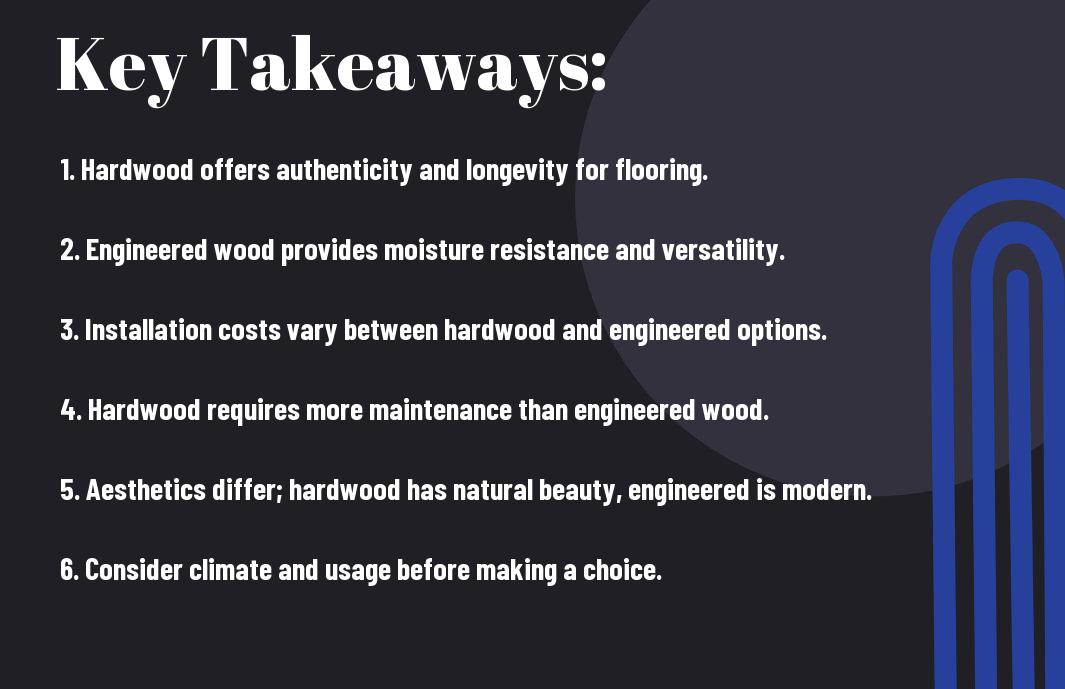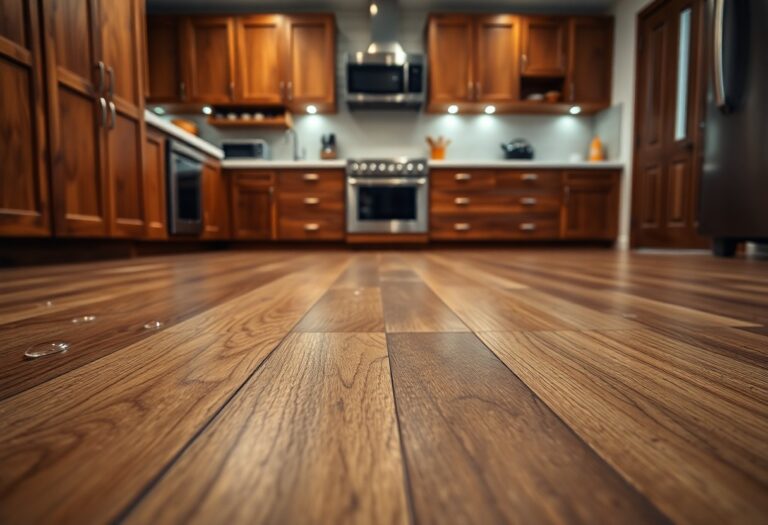You may be wondering which flooring option is best for your home: traditional hardwood or engineered wood. Each choice offers unique benefits and potential drawbacks, and understanding these differences can help you make an informed decision. In this post, we will explore key factors like durability, maintenance, aesthetics, and cost to help you determine which flooring type aligns with your lifestyle and preferences. Whether you prefer the timeless appeal of hardwood giants or the modern convenience of engineered wood, your ideal flooring solution is just a few insights away.

Understanding Hardwood Giants
Before you explore into the world of flooring choices, it’s important to understand what constitutes hardwood giants. Hardwood flooring is derived from deciduous trees, such as oak, maple, and cherry, known for their dense structure and durability. These trees take decades to mature, resulting in thick planks that can be refinished multiple times throughout their lifespan. When you choose hardwood, you’re selecting a product that embodies timeless beauty, showcasing natural grain patterns and rich colors that can add significant value to your home.
Characteristics of Hardwood
Among the many characteristics that define hardwood, its distinctive appearance and resilience stand out. Each piece of hardwood flooring is unique, with variations in pattern and color that reflect the tree’s natural growth. The density of hardwood also gives it a robust quality, making it highly resistant to wear and tear, a trait that can be particularly advantageous in high-traffic areas of your home. Additionally, hardwood is known for its ability to maintain warmth and comfort underfoot, contributing positively to your home’s overall atmosphere.
Advantages and Disadvantages
Giants in the flooring world, hardwood floors boast numerous advantages that appeal to many homeowners. Their aesthetic appeal is unparalleled – hardwood exudes sophistication and elegance that can elevate any room. Furthermore, hardwood is durable and can last a lifetime when properly maintained. However, there are also disadvantages to consider, such as susceptibility to scratches and dents, especially in homes with pets or children. Additionally, hardwood can be sensitive to moisture changes, which may lead to warping or cracking if exposed to excessive humidity.
This delicate balance of pros and cons is necessary to weigh when considering hardwood for your home. While the initial investment might be higher than other flooring options, the longevity and timeless appeal of hardwood can ultimately provide you with greater value over time. However, if your lifestyle involves high wear, potential moisture exposure, or a need for easy maintenance, you might find yourself grappling with whether hardwood is the ideal choice for your specific needs.

Exploring Engineered Wood
What is Engineered Wood?
After gaining popularity in recent years, engineered wood is a versatile material that is designed to mimic the appearance of solid hardwood while providing enhanced stability and durability. This type of wood product is manufactured by combining multiple layers of wood veneers, strands, or fibers and bonding them together with adhesives. The final product not only captures the aesthetic qualities of hardwood but also offers improved performance in various environments, making it an appealing option for many homeowners.
Engineered wood is often used in a wide array of applications, including flooring, cabinetry, and furniture. Its layered construction allows it to withstand changes in temperature and humidity, reducing the risk of warping or cracking. This can be particularly beneficial in areas with fluctuating climates or in homes where moisture is a concern.
Benefits and Drawbacks
Before making a decision between engineered wood and hardwood, it’s important to weigh the benefits and drawbacks of engineered wood. One of the standout advantages is its stability in comparison to solid wood. The construction of engineered wood makes it less prone to expanding and contracting, which can be a significant factor in high-moisture areas like basements or kitchens. Additionally, you may find engineered wood to be more budget-friendly, as it often offers a similar aesthetic to hardwood at a lower price point.
On the flip side, it’s important to consider that while engineered wood can closely resemble hardwood, it may not add the same level of value to your home. The market perception of engineered wood may lead to a lower resale value compared to traditional hardwood flooring. Also, some varieties of engineered wood may have a limited lifespan, particularly if they are of lower quality. The thin top layer of hardwood veneer may wear down over time and limit your options for refinishing the surface.
Exploring the benefits and drawbacks of engineered wood allows you to make a well-informed decision that fits your lifestyle and home requirements. You should consider factors such as your budget, the location of the flooring, and your long-term expectations. Delving deeper into the specifics will help you find the perfect match for your home, ensuring you make an investment that aligns with your needs and preferences.
Comparison of Aesthetics
All homeowners appreciate the visual impact that flooring has on their living spaces. In terms of hardwood giants versus engineered wood, the aesthetics of both options can significantly influence your choice. While both types offer unique characteristics, understanding how they compare can help you make an informed decision based on your home’s style and your personal tastes.
Visual Appeal
| Hardwood Giants | Engineered Wood |
|---|---|
| Natural beauty with unique grain patterns and colors | Offers a wide range of styles and finishes, mimicking hardwood |
| Timeless and classic aesthetic | Can suit contemporary and diverse interior designs |
| Enhances the value and elegance of your home | More affordable alternatives with appealing appearances |
Customization Options
Along with visual appeal, customization options play a significant role in your flooring choice. With hardwood giants, you generally have fewer choices when it comes to variations in color and finish since they are cut from solid wood. However, these variations contribute uniquely to the character of each board, ensuring that no two floors look exactly alike. Alternatively, engineered wood allows for more versatility in design, giving you the ability to choose from a vast array of colors, textures, and wood species, making it easier to find the perfect look for your home.
Options like stains and finishes can further enhance either flooring type, but engineered wood products often allow for a more extensive selection to match your aesthetic preferences. Moreover, you can usually find engineered wood in various formats, such as distressed or wire-brushed finishes, all designed to give your living space a specific atmosphere. This flexibility in customization makes engineered wood an appealing choice for those seeking a personalized touch in their flooring choice.
Durability and Longevity
To ensure your flooring investment pays off, understanding the durability and longevity of both hardwood and engineered wood is vital. Hardwood floors are renowned for their ability to withstand the test of time, often lasting several decades when properly maintained. These natural wood floors can be sanded and refinished multiple times, allowing you to restore their beauty and prolong their lifespan. Engineered wood, on the other hand, offers a slightly different advantage; although it may not last as long as solid hardwood, its multi-layer construction provides stability and resistance to warping, making it a smart choice for certain environments.
Performance in High Traffic Areas
Below, you’ll find that high traffic areas in your home demand flooring that can endure significant wear and tear. Solid hardwood is a popular choice for its resilience and the ability to develop a patina over time, which can enhance its appearance. However, in areas prone to heavy foot traffic such as hallways and family rooms, engineered wood may outperform its hardwood counterpart. Engineered wood is designed with a thicker top layer of hardwood but has a core made of plywood or high-density fiberboard. This design enables it to resist expansion and contraction and maintain its structural integrity under pressure, making it an excellent alternative for busy households.
Resistance to Wear and Tear
Against the backdrop of daily life, the resistance to wear and tear in flooring surfaces is necessary to maintaining aesthetic appeal and functionality. Hardwood flooring can face scrapes and scuffs over time, particularly in high-traffic areas, and while it can be refinished to remove these imperfections, this process requires a considerable investment of time and effort. Conversely, engineered wood is often treated with advanced finishes that enhance its resistance to scratches and dents, allowing it to consistently look great even in bustling homes.
Consequently, if you prioritize durability and longevity in your flooring choice, engineered wood might be the better option for busy sectors of your home. Its superior resistance to wear enables it to endure the hustle and bustle of daily life with minimal upkeep. Additionally, while hardwood can be refinished, the convenience and stability of engineered wood offer a practical solution in environments where wear from foot traffic is a key consideration. Ultimately, considering how each option performs over time will guide you to the right flooring decision for your specific needs.
Cost Considerations
Initial Investment
After deciding on the aesthetic and practical benefits of hardwood giants or engineered wood, one of the first aspects you’ll need to evaluate is the initial investment. Generally, solid hardwood flooring tends to be more expensive upfront due to the quality of the material and the intricate installation process required. Prices can vary significantly depending on the type of wood you choose, the room size, and labor costs. In contrast, engineered wood typically comes at a lower price point, making it a more budget-friendly option for those seeking a wood-like appearance without the hefty price tag of solid hardwood.
Long-Term Value
Considerations for long-term value play an important role in your decision-making process. While hardwood flooring may incur a higher initial cost, its durability and timeless appeal can often lead to increased property value over time, not to mention its potential longevity—with proper care, hardwood can last for decades, if not generations. Engineered wood, meanwhile, while more affordable, may not offer the same return on investment when it comes time to sell your home, primarily due to its composite nature and perceived lower status in the flooring market.
Initial expectations surrounding the lifespan of your flooring choice can greatly influence long-term value. When you consider maintenance, repair, and potential replacement costs, solid hardwood may offer more savings in the long run. If you focus on the aesthetic appeal and enduring quality, investing in hardwood giants could pay off not just in comfort but also in your property’s value growth. Engineered wood can serve you well in homes with less foot traffic or as a temporary solution, but knowing that you may need to replace it sooner could affect your overall investment strategy.
Environmental Impact
Unlike hardwood giants, which require extensive time and resources to grow, engineered wood products often boast a more favorable environmental impact. The manufacturing process for engineered wood involves adhesives and fibers derived from smaller trees and wood scraps, making it a more efficient use of available timber resources. This method not only reduces waste but also minimizes the demand for large-scale logging operations that can devastate forests and ecosystems. Thus, you can consider engineered wood as a responsible choice in terms of resource usage.
Sustainability of Hardwood
At the same time, hardwood can also be a sustainable option if sourced responsibly. Certification programs like the Forest Stewardship Council (FSC) ensure that the hardwood you choose comes from forests managed sustainably. This means that for every tree harvested, more are planted, helping to maintain biodiversity and reduce carbon footprints. If you prioritize sustainability, searching for certified hardwood products can provide you with pieces that contribute positively to the environment.
Eco-Friendly Features of Engineered Wood
With engineered wood, you’re looking at a flooring option that incorporates eco-friendly features without compromising on quality or durability. This type of wood often includes a thin veneer of real hardwood over layers of plywood or high-density fiberboard. The use of lower-quality materials in the inner layers means that engineered wood products can maximize the use of forest resources while still providing the aesthetic appeal and performance of hardwood.
It’s also important to note that many engineered wood products are designed to be free of harmful chemicals, such as formaldehyde, making them safer for your home environment. As a result, you can enjoy the beauty of wood flooring while feeling confident that your choice is contributing to a healthier home and planet. By opting for certified engineered wood, you help support sustainable practices and protect natural resources for future generations.
Conclusion
Upon reflecting on the choice between hardwood giants and engineered wood for your home, it’s important to consider several factors that align with your lifestyle and preferences. Hardwood flooring exudes timeless elegance and durability, making it a popular choice for those who value traditional aesthetics and long-term investment. However, engineered wood presents a compelling alternative, especially for homeowners in areas with fluctuating humidity or those seeking easier installation and maintenance. Evaluating the specific conditions of your home and your priorities will guide you toward the right option.
Ultimately, the decision should be based on your needs and vision for your living space. If you appreciate the unique character and warmth of natural hardwood, it may serve you well for generations. Conversely, if you prefer a more versatile, moisture-resistant option that can still offer a beautiful appearance, engineered wood could be the appropriate choice. By weighing the pros and cons of each type, you can confidently choose the flooring that best suits your home and enhances your lifestyle.





